- State Board
-
12th Standard
-

Biology
-

Computer Applications
-

Computer Science
-

Business Maths and Statistics
-

Commerce
-

Economics
-

Maths
-

Chemistry
-

Physics
-

Computer Technology
-

History
-

Accountancy
-

Tamil
-

Maths
-

Chemistry
-

Physics
-

Biology
-

Computer Science
-

Business Maths and Statistics
-

Economics
-

Commerce
-

Accountancy
-

History
-

Computer Applications
-

Computer Technology
-

English
12th Standard stateboard question papers & Study material
தமிழ் Subjects
English Subjects
-
-
11th Standard
-

Maths
-

Biology
-

உயிரியல் - தாவரவியல்
-

Economics
-

Physics
-

Chemistry
-

History
-

Business Maths and Statistics
-

Computer Science
-

Accountancy
-

Commerce
-

Computer Applications
-

Computer Technology
-

Tamil
-

Maths
-

Commerce
-

Economics
-

Biology
-

Business Maths and Statistics
-

Accountancy
-

Computer Science
-

Physics
-

Chemistry
-

Computer Applications
-

History
-

Computer Technology
-

Tamil
-

English
11th Standard stateboard question papers & Study material
தமிழ் Subjects
English Subjects
-
-
9th Standard
-

-

-

-

-

-

-

Maths
-

Science
-

Social Science
-

Maths
-

Science
-

Social Science
9th Standard stateboard question papers & Study material
தமிழ் Subjects
English Subjects
-
-
6th Standard
-

Maths
-

Science
-

Social Science
-

Maths
-

Science
-

Social Science
6th Standard stateboard question papers & Study material
தமிழ் Subjects
English Subjects
-
-
10th Standard
-

Maths
-

Science
-

Social Science
-

Tamil
-

Maths
-

Science
-

Social Science
-

English
-

English
10th Standard stateboard question papers & Study material
தமிழ் Subjects
English Subjects
-
-
7th Standard
-

Maths
-

Science
-

Maths
-

Science
-

Social Science
7th Standard stateboard question papers & Study material
தமிழ் Subjects
English Subjects
-
-
8th Standard
-

கணிதம் - old
-

Science
-

Social Science
-

கணிதம்
-

Maths
-

Science
-

Social Science
8th Standard stateboard question papers & Study material
தமிழ் Subjects
English Subjects
-
-
12th Standard
- CBSE Board
-
12th Standard CBSE
-

Biology
-

Chemistry
-

Physics
-

Maths
-

Accountancy
-

Business Studies
-

Economics
-

Introductory Micro and Macroeconomics
-

Computer Science
-

Geography
-

English
-

History
-

Indian Society
-

Physical Education
-

Sociology
-

Political Science
-

Engineering Graphics
-

Bio Technology
-

Entrepreneurship
-

Hindi Elective
-

Home Science
-

Legal Studies
-

Psychology
-

Hindi Core
-

Tamil
12th Standard CBSE Subject Question Paper & Study Material
-
-
11th Standard CBSE
-

Physics
-

Mathematics
-

Chemistry
-

Biology
-

Economics
-

Business Studies
-

Accountancy
-

Computer Science
-

English
-

Geography
-

History
-

Physical Education
-

Psychology
-

Sociology
-

Bio Technology
-

Enterprenership
-

Hindi
-

Home Science
-

Political Science
-

Applied Mathematics
11th Standard CBSE Subject Question Paper & Study Material
-
- 10th Standard CBSE
-
9th Standard CBSE
-

Social Science
-

Mathematics
-

Science
-

English
-

Hindi
9th Standard CBSE Subject Question Paper & Study Material
-
-
8th Standard CBSE
-

Social Science
-

Science
-

Mathematics
-

English
8th Standard CBSE Subject Question Paper & Study Material
-
-
7th Standard CBSE
-

Social Science
-

Science
-

Mathematics
-

English
7th Standard CBSE Subject Question Paper & Study Material
-
-
6th Standard CBSE
-

Social Science
-

Science
-

Mathematics
-

English
6th Standard CBSE Subject Question Paper & Study Material
-
-
12th Standard CBSE
- Free Online Test
- News
- Study Materials
-
Students
-

Stateboard Tamil Nadu
-

CBSE Board
-

Free Online Tests
-

Educational News
-

Scholarships
-

Entrance Exams India
-

Video Materials
Study Materials , News and Scholarships
-
-
Students

11th Standard Physics English Medium - Revision Model Question Paper with Answer Key 2022 - 2023 Study Materials Dec-31 , 2022
QB365 provides a detailed and simple solution for every Possible Questions in Class 11 Physics Subject - Revision Model Question Paper, English Medium. It will help Students to get more practice questions, Students can Practice these question papers in addition to score best marks.
11th Standard Physics Revision Model Question Paper With Answer key
11th Standard
-
Reg.No. :
Physics
Time :
02:30:00 Hrs
Total Marks :
70
-
If the error in the measurement of radius is 2%, then the error in the determination of volume of the sphere will be
(a)8%
(b)2%
(c)4%
(d)6%
-
A ball is projected vertically upwards with a velocity v. It comes back to ground in time t. Which v-t graph shows the motion correctly?
(a) (b)
(b) (c)
(c) (d)
(d)
-
Choose appropriate free body diagram for the particle experiencing net acceleration along negative y direction. (Each arrow mark represents the force acting on the system).
(a)(b)(c)(d) -
A uniform force of (2\(\hat { i }\)+\(\hat { j }\)) N acts on a particle of mass 1 kg. The particle displaces from position (3\(\hat { j }\)+\(\hat { k }\)) m to (5\(\hat { i }\)+3\(\hat { j }\)) m. The work done by the force on the particle is
(a)9 J
(b)6 J
(c)10 J
(d)12 J
-
A disc of the moment of inertia Ia is rotating in a horizontal plane about its symmetry axis with a constant angular speed \(\omega\). Another disc initially at rest of moment of inertia Ib is dropped coaxially on to the rotating disc. Then, both the discs rotate with the same constant angular speed. The loss of kinetic energy due to friction in this process is,
(a)\(\frac { 1 }{ 2 } \frac { { I }_{ b }^{ 2 } }{ 2({ I }_{ a }+{ I }_{ b }) } { \omega }^{ 2 }\)
(b)\(\frac { { I }_{ b }^{ 2 } }{ ({ I }_{ a }+{ I }_{ b }) } { \omega }^{ 2 }\)
(c)\(\frac { { ({ I }_{ b }-{ I }_{ a }) }^{ 2 } }{ ({ I }_{ a }+{ I }_{ b }) } { \omega }^{ 2 }\)
(d)\(\frac { 1 }{ 2 } \frac { { { I }_{ b }{ I }_{ b } } }{ ({ I }_{ a }+{ I }_{ b }) } { \omega }^{ 2 }\)
-
If the mass and radius of the Earth are both doubled, then the acceleration due to gravity g'
(a)remains same
(b)\({g\over 2}\)
(c)2g
(d)4g
-
The load – elongation graph of three wires of the same material are shown in figure. Which of the following wire is the thickest?
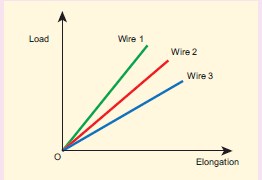 (a)
(a)wire 1
(b)wire 2
(c)wire 3
(d)all of them have same thickness
-
When a cycle tyre suddenly bursts, the air inside the tyre expands. This process is
(a)isothermal
(b)adiabatic
(c)isobaric
(d)isochoric
-
The following graph represents the pressure versus number density for ideal gas at two different temperatures T1 and T2. The graph implies
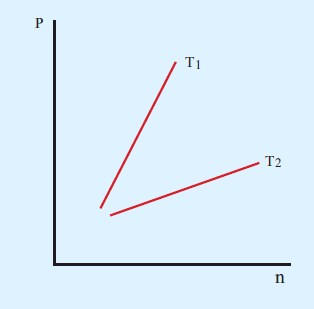 (a)
(a)T1 = T2
(b)T1 > T2
(c)T1 < T2
(d)Cannot be determined
-
The time period for small vertical oscillations of block of mass m when the masses of the pulleys are negligible and spring constant k1 and k2 is
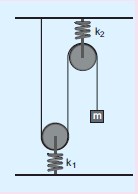 (a)
(a)\(T=4\pi \sqrt { m\left( \frac { 1 }{ { k }_{ 1 } } +\frac { 1 }{ { k }_{ 2 } } \right) } \)
(b)\(T=2\pi \sqrt { m\left( \frac { 1 }{ { k }_{ 1 } } +\frac { 1 }{ { k }_{ 2 } } \right) } \)
(c)\(T=4\pi \sqrt { m\left( { k }_{ 1 }+{ k }_{ 2 } \right) } \)
(d)\(T=2\pi \sqrt { m\left( { k }_{ 1 }+{ k }_{ 2 } \right) } \)
-
Which of the following options is correct?.
A B (1) Quality (A) Intensity (2) Pitch (B) Waveform (3) Loudness (C) Frequency Options for (1), (2) and (3), respectively are
(a)(B), (C) and (A)
(b)(C), (A) and (B)
(c)(A), (B) and (C)
(d)(B), (A) and (C)
-
A uniform rope having mass m hangs vertically from a rigid support. A transverse wave pulse is produced at the lower end. Which of the following plots shows the correct variation of speed v with height h from the lower end?
(a) (b)
(b) (c)
(c) (d)
(d)
-
How many light years make 1 per sec?
(a)3.26
(b)6.67
(c)1.5
(d)9.4
-
How many \(\mu\)m present in one metre?
(a)10-6 \(\mu\)m
(b)106 \(\mu\)m
(c)10-3 \(\mu\)m
(d)10-2 \(\mu\)m
-
In hot summer after a bath, the body’s
(a)internal energy decreases
(b)internal energy increases
(c)heat decreases
(d)no change in internal energy and heat
-
State principle of moments.
-
State Kepler’s three laws.
-
A wire 10 m long has a cross-sectional area 1.25\(\times\)10-4 m2. It is subjected to a load of 5 kg. If Young’s modulus of the material is 4\(\times\)1010 N m-2, calculate the elongation produced in the wire. Take g = 10 ms-2.
-
We can cut vegetables easily with a sharp knife as compared to a blunt knife. Why?
-
A person does 30 kJ work on 2 kg of water by stirring using a paddle wheel. While stirring, around 5 kcal of heat is released from water through its container to the surface and surroundings by thermal conduction and radiation. What is the change in internal energy of the system?
-
What is PV diagram?
-
Classify the following motions as periodic and non-periodic motions?
a. Motion of Halley’s comet.
b. Motion of clouds.
c. Moon revolving around the Earth -
An increase in pressure of 100 kPa causes a certain volume of water to decrease by 0.005% of its original volume.
(a) Calculate the bulk modulus of water?
(b) Compute the speed of sound (compressional waves) in water? -
Write a note an scope of physics.
-
A solid sphere has a radius of 1.5 cm and a mass of 0.038 kg. Calculate the specific gravity or relative density of the sphere.
-
When you mix a tumbler of hot water with one bucket of normal water, what will be the direction of heat flow? Justify.
-
What is a thermal expansion?
-
An oxygen molecule is travelling in air at 300 K and 1 atm, and the diameter of oxygen molecule is 1.2\(\times\)10−10m. Calculate the mean free path of oxygen molecule.
-
Show that for a simple harmonic motion, the phase difference between
a. displacement and velocity is \(\frac{\pi}{2}\) radian or 90°.
b. velocity and acceleration is \(\frac{\pi}{2}\) radian or 90°.
c. displacement and acceleration is \(\pi\) radian or 180°. -
Explain damped oscillation. Give an example.
-
N tuning forks are arranged in order of increasing frequency and any two successive tuning forks give n beats per second when sounded together. If the last fork gives double the frequency of the first (called as octave), Show that the frequency of the first tuning fork is f = (N−1)n.
-
Differentiate fundamental quantities from derived quantities.
-
In a physical units, how many units are there in 1 metre?
1 Astronomical unit (AU = 1.496\(\times\)1011 m)
Given data:
1 AU = 1.496\(\times\)1011m
1 ly = 9.467 x \(\times\)1015m
1 mm = 10-6m
1 parsec = 3.08\(\times\)1016m -
-
Explain in detail the triangle law of addition.
-
State and explain work energy principle. Mention any three examples for it.
-
-
-
Explain in detail the Eratosthenes method of finding the radius of Earth.
-
Explain in detail the isochoric process.
-
-
-
Describe the vertical oscillations of a spring.
-
Explain how overtones are produced in a
(a) Closed organ pipe
(b) Open organ pipe
-
-
-
The value Gin CGS system is 6.67\(\times\)10-8 dyne cm2 g-2. Calculate the value in SI units.
-
The frequency of vibration of a string depends of on,
(i) tension in the string
(ii) mass per unit length of string
(iii) vibrating length of the string
Establish dimensionally the relation for frequency.
-
-
-
Defineangular velocity and angular displacement.
-
A bus starting from rest moves with a uniform acceleration of 0.2 ms-2 for 3 minutes. Find the speed and distance travelled.
-
PART-I
Note : i ) All Questions Are Compulsory.
ii) Choose The Most Suitable Answer From The Given Four Correct Alternatives.
15 x 1 = 15
PART-II
Note : i
) Answer any Six Questions and Question.No: 24 is compulsory.
6x 2 = 12
PART-III
Note : i
) Answer any Six Questions and Question.No: 33 is compulsory.
6 x 3 = 18
PART-IV
Note : i ) Write all the following questions.
5 x 5 = 25
*****************************************
Answers
-
(d)
6%
-
(c)
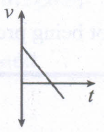
-
(c)
-
(c)
10 J
-
(d)
\(\frac { 1 }{ 2 } \frac { { { I }_{ b }{ I }_{ b } } }{ ({ I }_{ a }+{ I }_{ b }) } { \omega }^{ 2 }\)
-
(b)
\({g\over 2}\)
-
(a)
wire 1
-
(b)
adiabatic
-
(b)
T1 > T2
-
(a)
\(T=4\pi \sqrt { m\left( \frac { 1 }{ { k }_{ 1 } } +\frac { 1 }{ { k }_{ 2 } } \right) } \)
-
(a)
(B), (C) and (A)
-
(d)
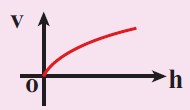
-
(a)
3.26
-
(b)
106 \(\mu\)m
-
(a)
internal energy decreases






 11th Standard Physics Syllabus
11th Standard Physics Syllabus  11th Standard Physics Study Materials
11th Standard Physics Study Materials 11th Standard Physics MCQ Practise Tests
11th Standard Physics MCQ Practise Tests 

Reviews & Comments about 11th Standard Physics English Medium - Revision Model Question Paper with Answer Key 2022 - 2023
Write your Comment